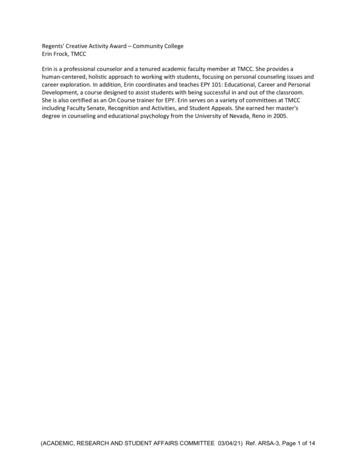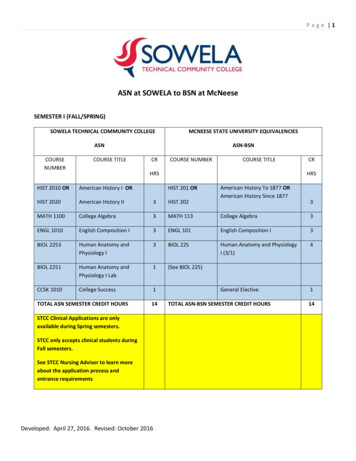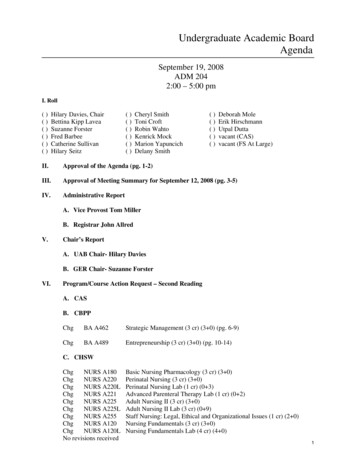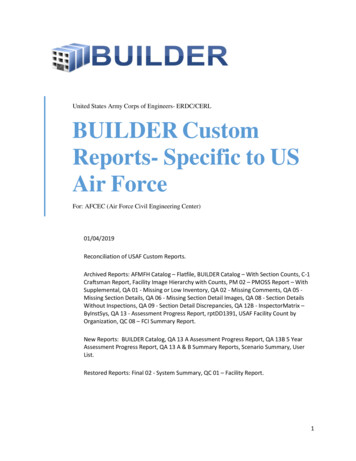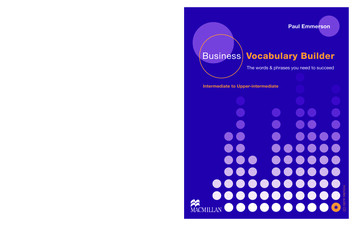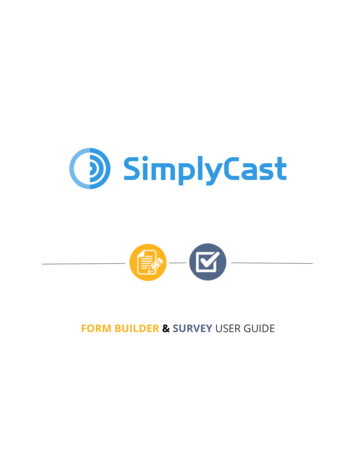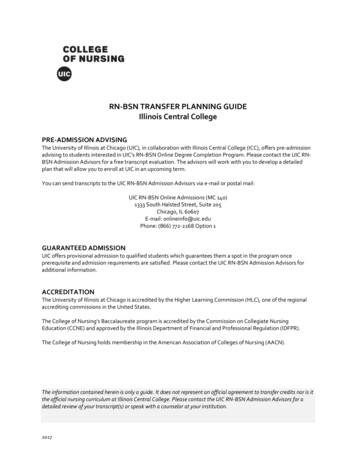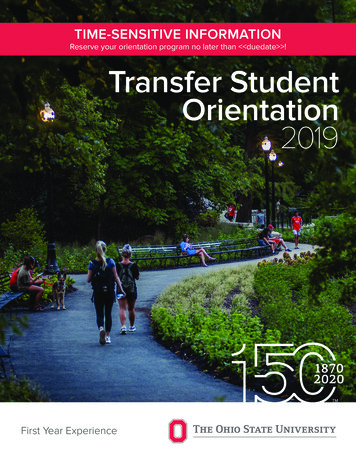
Transcription
Nursing Orientation Program Builder: Essential Tools for Onboarding, Orientation, and Transition to Practice ispublished by HCPro, a division of BLR.Copyright 2016 HCPro, a division of BLRAll rights reserved. Printed in the United States of America.5 4 3 2 1ISBN: 978-1-68308-132-6No part of this publication may be reproduced, in any form or by any means, without prior written consent ofHCPro or the Copyright Clearance Center (978-750-8400). Please notify us immediately if you have received anunauthorized copy.HCPro provides information resources for the healthcare industry.HCPro is not affiliated in any way with The Joint Commission, which owns the JCAHO and Joint Commissiontrademarks.Diana Swihart, PhD, DMIN, MSN, APN, CS, RN-BC, FAAN, AuthorSolimar Figueroa, PhD, MSN, MHA, BSN, RN, P-PCA, AuthorMichelle Clarke, Managing EditorErin Callahan, Vice President, Product Development & Content StrategyElizabeth Petersen, Executive Vice President, HealthcareMatt Sharpe, Production SupervisorVincent Skyers, Design Services DirectorVicki McMahan, Sr. Graphic DesignerAngel M. Cruz, Layout/Graphic DesignMichael McCalip, Cover DesignerAdvice given is general. Readers should consult professional counsel for specific legal, ethical, or clinical questions.Arrangements can be made for quantity discounts. For more information, contact:HCPro100 Winners CircleSuite 300Brentwood, TN 37027Telephone: 800-650Email: customerservice@hcpro.comVisit HCPro online at www.hcpro.com and www.hcmarketplace.com.
Table of ContentsAbout the Authors .iiiPreface .viContinuing Education Instructional Guide .xiiiPart I. Onboarding Processes .1Chapter 1. New-Hire Wayfinding .3Chapter 2. Prehire Activities . 13Chapter 3. Preceptorships .37Part II. Organization and Service-Specific Orientations .75Chapter 4. Organizing and Facilitating Onboarding Processes .77Chapter 5. Quality and Safety for New Employees .91Chapter 6. Regulatory Agencies and Mandatory Requirements for NewEmployees . 101Chapter 7. Creating Service-Specific Orientations . 113Chapter 8. Competency-Based Orientation Activities in Practice Settings . 133 2016 HCProNursing Orientation Program Builder iii
ContentsChapter 9. Simulations in Onboarding New Employees .155Chapter 10. Evidence-Based Practice, Critical Thinking, Clinical Judgment,and Priorities .167Chapter 11. Leadership: Authority, Accountability, Ownership, andDelegation . 179Chapter 12. Interprofessional and Team-Based Onboarding. 197Chapter 13. Supporting New Graduate Employees . 211Chapter 14. Evaluating Onboarding Processes and Orientation ActivitiesOutcomes .221Chapter 15. Mentorships for New-Employees.253Part III. After Onboarding and Orientation: Processes to Improve Transition toPractice .271Chapter 16. Communication Skills and Barriers .273Chapter 17. Ethical Dilemmas and Legal Considerations .289Chapter 18. Culture and Diversity: Orienting Foreign-Educated Nurses .301Chapter 19. Stress Management, Change, and Renewal . 313Chapter 20. A Chapter for Educators and Professional DevelopmentSpecialists .327Chapter 21. Tips for Building and Improving New-Employee Programs .347Bibliography .357iv Nursing Orientation Program Builder 2016 HCPro
About the AuthorsDiana Swihart, PhD, DMin, MSN, APN CS, RN-BC, FAANDr. Diana Swihart, is a consulting partner with the Forum for Shared Governance and the CEOand Managing Partner for the American Academy for Preceptor Advancement and enjoys manyroles in her professional career, practicing in widely diverse clinical and nonclinical settings. Anauthor, speaker, researcher, educator, and consultant, she has published and spoken nationallyand internationally on a number of topics related to servant leadership, preceptors, sharedgovernance, new-employee onboarding and orientation, competency assessment, professionaldevelopment, Magnet Recognition Program , research, and evidence-based practice.Dr. Swihart has served on the editorial advisory board for the Journal of Nursing Regulation and as an ANCC Magnet Recognition Program appraiser, as a board member for theANCC Commission on Accreditation Commission, as the treasurer for the Association forNursing Professional Development (prior to its name change), and as adjunct faculty atSouth University and Trinity Theological Seminary and College of the Bible distance learning programs. In 2015, Dr. Swihart was inducted as a fellow into the American Academy ofNursing for her work in developing preceptor specialty practice and certification.Solimar Figueroa, PhD, MSN, MHA, BSN, RN, P-PCADr. Solimar Figueroa brings more than 30 years of experience in her professional nursingpractice. Now a Clinical Educator II in her current hospital-based position, her practice emanated from the Philippines, Kingdom of Saudi Arabia, Michigan, and Florida. Dr. Figueroa’sexperience includes operating room nurse, operating room in-charge nurse, director of nursing,chief nursing officer, assistant director of nursing, clinical educator, director clinical services,and certified preceptor specialist.Dr. Figueroa serves as an appraiser with the American Nurses Credentialing Center (ANCC) forcontinuing education and the Practice Transition Accreditation Program and manages theClinical Collaborations for the American Academy for Preceptor Advancement (AAPA). She hasmaster’s degrees in nursing and ealthcare administration and her PhD is in nursing. She is anauthor, speaker, researcher, educator, and consultant. Her primary interests are preceptorshipand leadership in healthcare and education. 2016 HCProNursing Orientation Program Builder v
DedicationsDedicationsJudie Bopp reminds us: The capacity to watch over and guard the well-being of others is animportant gift, and one that is learned with great difficulty. For it is one thing to see the situation others are in, but it is quite another to care enough about them to want to help, and yetanother to know what to do. This work is dedicated to nurses and healthcare workers at everylevel of clinical and academic service, the staff, nurse leaders, educators, and executives in allhealthcare professions who participate in onboarding new hires by developing, empowering, andsupporting every one.—Diana Swihartvi Nursing Orientation Program Builder 2016 HCPro
AcknowledgmentsAcknowledgmentsEvery work, regardless of scope and size, is completed only with the help and inspiration ofothers. My heart and sincere thanks go to my beloved husband, Dr. Stan, for your support,encouragement, and unwavering belief in me.To my amazingly gifted partner and co-author, Dr. Solimar Figueroa, thank you! You havebeen a steadfast friend and colleague for many years, traveling with me through valleys andacross mountaintops! So much I have accomplished these past few years would not have beenpossible without you (and your beloved Omie)!I would also like to acknowledge those many nurses and other healthcare providers, patientsand community partners, speakers and teachers, and colleagues and friends who have contributed their ideas and thoughts through countless classes, seminars, lectures, and discussions over the years. I write from their influence and want to recognize their contributions aswell. Though their names are too numerous to list, many others can be found in this workand in the extensive bibliography. To each and every one of you, thank you.—Diana Swihart, PhD, DMin, MSN, APN CS, RN-BC, FAANTo my sweetheart, my agape, my dearly loved Omie: Your unconditional love, support, and faithin my abilities are the reasons behind my successes, in addition to God’s blessings. I thank youfor everything. To my children, Jaeger and Nathan, you inspire me to be the mom I needed tobe.I also wish to acknowledge Dr. Swihart, who believed in me from the very beginning of ourrelationship and guided me through my professional journey. To all of my colleagues and friendswho dreamt with me, I thank you for your support and encouragement. Thank you all for beinga part of my success. To my mom Helen, who made night into day so I could go to the bestschool, I am proud to be your daughter. I am who I am today because of the sacrifices you made.Mahal kita Nanay Helen. To the Espino family, Kuya Fred and Ate Fely, thank you so much forloving us unconditionally despite all our shortcomings. Your support is truly a blessing—Solimar Figueroa, PhD, MSN, MHA, BSN, RN, P-PCA 2016 HCProNursing Orientation Program Builder vii
PrefaceSo never lose an opportunity of urging a practical beginning, however small, for it is wonderful howoften in such matters the mustard-seed germinates and roots itself ʊ)ORUHQFH 1LJKWLQJDOHNew employees need practical and pragmatic preparation and support to successfully engage intheir new roles and responsibilities. To meet the present and future demands of increasinglycomplex healthcare practice settings, new hires need opportunities to advance their communication, collaboration, and collegial skills. When you build strong onboarding processes, orientation events, and preceptorships, you can provide such opportunities to help new hires align withthe mission, vision, values, and culture of your organization. People tend to stay with organizations that support and encourage them. To do so successfully through onboarding and orientation, you need some strategies and tools.The purpose of The Nursing Orientation Program Builder is to provide leaders, educators,preceptors, and staff with the essential tools and ideas for practical approaches for creatingeffective onboarding and orientation programs to meet the evolving needs of new hires enteringtheir organizations. In this book, you will find a compilation of information and tools frommultiple thought leaders in nursing, education, and preceptoring to help you build effective andefficient new-employee programs.The goals for this book are to provide a “big picture” process and some current definitions fromthe literature reflected in clinical practice believed to be important when onboarding, orienting, andpreceptoring new employees to healthcare systems and medical centers. The unique needs of anorganization or service depend on so many variables. That said, this book cannot provide the manyunique elements inherent in orientations to organizations, services or departments, or disciplines(i.e., checklists for specific skills, reviews of physiology, medications for particular patient populations, or services directed at orthopedics, labor and delivery, emergency care, etc.). However, thetools, tips, and templates can be adapted and folded into any size of orientation for any targetgroup of new hires. The content has been kept somewhat generic whenever possible to facilitateyour ability to build an effective and efficient new-employee program to meet YOUR needs.viii Nursing Orientation Program Builder 2016 HCPro
PrefaceThe Nursing Orientation Program Builder includes best practices, case studies, and informationto help educators, leadership, and organizations create and refine their onboarding processes,orientation, and preceptoring activities, such as: Alignment with organizational culture and climate Mission, vision, and values National standards for quality and practice Regulatory requirements and competencies Evidence-based practice and research Interprofessional partnerships and unit team building Roles of nursing leadership Simulations in orientation New-employee programsThe Nursing Orientation Program Builder is organized into 21 chapters around a three-partstrategic and tactical process for building and implementing your own new-employee onboarding and orientation program. Part I explores onboarding processes. In Part II, tools and strategies are provided for (a) organization and (b) service-specific orientations. Finally, Part III movesus from building programs to transitioning new hires into interprofessional collaborative practice. Each chapter begins with an inspiring and thoughtful quote.Chapter 1 explains wayfinding for new hires through the processes and events of onboarding:recruitment, prehire, orientations, and preceptorships with transition to service.Chapter 2 looks more closely at the prehire activities related to job descriptions,recruitment, screening, and peer interviews. It identifies the components of a sampleposition description and competency validation process for new hires and presents theelements of a new-employee program. 2016 HCProNursing Orientation Program Builder ix
PrefaceChapter 3 reviews the importance of preceptoring new hires. It discusses how to identify andselect preceptors for new employees and describes the preceptorship experiences during theonboarding, orientation, and competency development phases of the new-employee program.Chapter 4 discusses ways to organize and facilitate onboarding processes by identifying goalsand objectives, engaging the workforce, and establishing a timeline for orientation activities.Chapter 5 reviews the role of quality management and continual improvement at points ofservice. It explores the role of clinical nurse leaders as partners in quality improvement andprovides tools to help new employees build competencies for monitoring nurse-sensitive qualityindicators and to collect, analyze, and apply data to patient outcomes.Chapter 6 guides you through some of the whitewater of regulatory agency andmandatory standards, policies, and agency requirements related to creating a safe andhealthy work environment.Chapter 7 provides tools and strategies for creating the service-specific orientations, for bridgingthe gaps in organization, service-specific, and unit or area onboarding processes, developingorientation activities, and for developing new hires through supporting preceptorships.Chapter 8 discusses the orientation and competency validation processes. It focuses on providingthe structure and processes generally folded into a preceptorship linked to the new-employeeprogram and applying Wright’s competency assessment model to the program.Chapter 9 offers strategies for folding simulations into new-employee onboarding processes.Case studies to use with or without special equipment invite participatory engagement inorientation activities.Chapter 10 explores evidence-based practice, critical thinking, clinical judgment, andpriority setting.Chapter 11 considers leadership within the organization, service, and unit or work area: authority, accountability, ownership, and delegation. For example, new hires need to know the leadership, management, and professional levels of authority and shared decision-making within theirnew environments of care through rounding and reports.x Nursing Orientation Program Builder 2016 HCPro
PrefaceChapter 12 draws interprofessional partners and team members into the new-employee onboarding process to orient new hires to team-based care and approaches for working together effectively. Tips and tools for building healthy teams and engaging in collaborative practice withstaff, interdisciplinary team members, and interprofessional partners are provided.Chapter 13 provides strategies and tools for supporting new graduates, for bridging the gapsinherent in transitioning from academia to practice and from orientation through residencies andinternships.Chapter 14 features the KBPM approach to evaluating outcomes of onboarding to measuresatisfaction, knowledge acquisition, and behavior; evaluate outcomes (satisfaction, analysis,influence); and analyze program expectations, statistical data, and program improvements.Chapter 15 reviews the importance of mentoring new hires. It discusses how to identify andselect mentors for new employees and describes the mentorship experiences during the onboarding, orientation, and competency development phases of the new-employee program.Chapter 16 dives into verbal and nonverbal communication skills and barriers, exploring theprinciples of accurate communication.Chapter 17 explores organizational ethics and the dilemmas they often present. Legal issues canarise when entering into new roles and responsibilities. This chapter provides information toopen this conversation in the safety of onboarding and preceptored activities.Chapter 18 offers strategies for working with foreign-educated new hires. Culture anddiversity permeate our society and healthcare settings. The same tools and approaches forworking with foreign-born or foreign-educated providers help build teams among diversepatient and provider groups.Chapter 19 emphasizes the criticality of personal and professional self-care and stressmanagement. As these new hires navigate their way through the many personal and workstressors encountered in new environments of care, these strategies and tools provide supportfor them to care for themselves and others. 2016 HCProNursing Orientation Program Builder xi
PrefaceChapter 20 is dedicated to educators and professional development specialists who often buildand manage your new-employee programs. This chapter speaks to evidence-based practiceand research, competencies, needs assessments, planning and implementation, programevaluation, and special considerations for onboarding and orientation activities. Associationsand committees provide resources, subject matter experts, and creative approaches to helpmature new-employee orientation activities.Chapter 21 lists some tips for building and improving new-employee programs.The information presented in the New Employee Nursing Orientation Program Builder reflectsthe research and opinions of the authors, contributors, and advisors. Information, tools, andapplications to practice are constantly shifting, changing, and evolving with new research andrecommendations for onboarding new hires and the developing ideas about the education andsupport they require to be successful.Because this book explores opportunities for preparing new hires for increasingly complex anduncertain work environments, we have provided you with some definitions, new theories andapproaches to teaching and advancing new employees, and tools to help you create your ownorientation programs. It is the authors’ sincere hope you will add this work to your library andconsider how you, too, might contribute to this growing body of knowledge and expertise.—Drs. Diana Swihart and Solimar Figueroaxii Nursing Orientation Program Builder 2016 HCPro
Continuing Education Instructional GuideContinuing Education Instructional GuideNursing Orientation Program BuilderTarget Audience Nursing Nursing education Staff development specialists Human resourcesStatement of NeedOnboarding processes and orientation events have been around for a long time. Coaches, preceptors, and mentors continue to bring new-employees into organizations and successfullytransition them into service. This book will help elevate and accelerate these processes, reducethe risk of failing—and losing—new-employees, and guide them in more quickly becomingproductive members of their new teams.It will provide definitions, tools, and evidence-based strategies and resources to help organizations recruit, hire, and retain the best-qualified employees and to provide them with a comprehensive, outcomes-focused onboarding and orientation program and methods to measuresuccessful integration into service and practice.Learning ObjectivesAt the completion of this continuing education activity, the learner will be able to: Describe the differences in onboarding, orientation, and preceptorships for newemployees Explain the role of climate, culture, and context of the organization for the new hire Identify the six basic levels for onboarding, orientation, and preceptorships for new hires 2016 HCProNursing Orientation Program Builder xiii
Continuing Education Instructional Guide Discuss best practices for recruiting and hiring knowledge-based workers List the benefits of a detailed job description Describe how peers can be involved in the interview process Describe the process for selecting and preparing preceptors for new hires Identify the basic elements needed to develop a preceptorship program policy to helpguide orientation of new hires and their transition to practice Discuss the roles of feedback and evaluation in preceptoring new hires Describe the goals and objectives of organization orientation State two ways to engage the workforce: curriculum and content Discuss frequency and timelines of organization orientations Identify quality considerations for new-employees Describe the Plan-Do-Check-Act (PDCA) cycle Discuss the role of root cause analyses in quality and safety activities Discuss the importance of including information on regulatory agencies in new-employeeorientation Examine the differences between licensure and certification State how the ASPIRE to Excellence quality framework is used to guide quality improvement efforts in healthcare for new-employees State the differences between organization and service-specific orientation Examine how to identify individuals’ orientation needs Discuss best practices for organization orientation that prepares employees for servicespecific orientation Discuss the importance of including simulations in new-employee orientationxiv Nursing Orientation Program Builder 2016 HCPro
Continuing Education Instructional Guide Describe the role of the standardized actor in simulations Discuss the differences in classification systems for simulation equipment: high, medium,and low fidelity State five characteristics of those who engage in critical thinking Discuss the role of evidence-based practice in critical thinking and reasoning Identify methodologies to incorporate priority setting into orientation Describe the different roles of managers or supervisors and leaders Define accountability and responsibility and levels of authority for new-employees Discuss collaboration and negotiation when delegating levels of authority Explain how team-based onboarding contributes to team building with new-employees Identify at least three interprofessional partners who participate in team-based care Describe at least two ways to integrate new-employees into unit-level or work teams Discuss academic preparation and continuing education requirements to be coveredduring orientation for new graduates Explore the transition period for new graduates during orientation Articulate the unique needs of newly credentialed professionals Differentiate between feedback and performance evaluation for measuring new-employeesatisfaction, knowledge acquisition, and behaviors assessed during new-employee orientation and preceptorships Briefly discuss Kirkpatrick and Kirkpatrick’s Business Partnership Model in new-employee orientation and preceptorships Apply evaluation principles to a new-employee orientation program as a whole Discuss the changes expected when transitioning new-employees from preceptorships tomentorships 2016 HCProNursing Orientation Program Builder xv
Continuing Education Instructional Guide State the mentor role and process when onboarding new hires Explore at least two ways to effectively match mentors and new-employees Examine the models and principles of effective communication Incorporate verbal and nonverbal communication skills in the workforce Discuss the diversity of culture communication Discuss the organization’s ethics model and policies for new-employees State at least five ethics principles for new-employees Identify the most common legal considerations when onboarding new-employees Consider the demographics and recruitment process for onboarding foreign-educatednew-employees Discuss at least two ethical considerations when onboarding foreign-educated employees Briefly explore at least two considerations unique to onboarding and orienting foreigneducated employees Review the change process and its impact on new-employees Identify the phases of reality shock during onboarding Discuss ways to help new-employees manage stress Identify essential content for preparing educators and professional development specialists to build and manage onboarding and new-employee orientation programs Discuss how educators and professional development specialists use evidence-basedpractice and research for onboarding new-employees Identify the five levels of program evaluation Consider at least three tips for building new-employee orientation programs Identify at least three ways to improve existing orientation programsxvi Nursing Orientation Program Builder 2016 HCPro
Continuing Education Instructional Guide List at least three best practices gleaned from this program builder to build and improveyour own onboarding process and new-employee orientation programFacultyDiana Swihart, PhD, DMin, MSN, APN CS, RN-BC, FAANDr. Diana Swihart is a consulting partner with the Forum for Shared Governance and the CEOand Managing Partner for the American Academy for Preceptor Advancement and enjoys manyroles in her professional career, practicing in widely diverse clinical and nonclinical settings. Anauthor, speaker, researcher, educator, and consultant, she has published and spoken nationallyand internationally on a number of topics related to servant leadership, preceptors, sharedgovernance, new-employee onboarding and orientation, competency assessment, professionaldevelopment, Magnet Recognition Program , research, and evidence-based practice.Dr. Swihart has served on the editorial advisory board for the Journal of Nursing Regulation, asan ANCC Magnet Recognition Program appraiser, as a board member for the ANCC Accreditation Commission, as the treasurer for the Association for Nursing Professional Development(prior to its name change), and as adjunct faculty at South University and Trinity TheologicalSeminary and College of the Bible distance learning programs. In 2015, Dr. Swihart was inducted as a fellow into the American Academy of Nursing for her work in developing preceptorspecialty practice and certification.Solimar Figueroa, PhD, MSN, MHA, BSN, RN, P-PCADr. Solimar Figueroa brings more than 30 years of experience in her professional nursing practice. Now a Clinical Educator II in her current hospital-based position, her practice emanatedfrom the Philippines, Kingdom of Saudi Arabia, Michigan, and Florida. Dr. Figueroa’s experience includes operating room nurse, operating room in-charge nurse, director of nursing, chiefnursing officer, assistant director of nursing, clinical educator, director of clinical services, andcertified preceptor specialist.Dr. Figueroa serves as an appraiser with the American Nurses Credentialing Center (ANCC) forcontinuing education and the Practice Transition Accreditation Program and manages theClinical Collaborations for the American Academy for Preceptor Advancement (AAPA). She hasmaster’s degrees in nursing and healthcare administration, and her PhD is in nursing. She is an 2016 HCProNursing Orientation Program Builder xvii
Continuing Education Instructional Guideauthor, speaker, researcher, educator, and consultant. Her primary interests are preceptorshipand leadership in healthcare and education.Continuing EducationNursing Contact Hours:HCPro is accredited as a provider of continuing nursing education by the American NursesCredentialing Center’s Commission on Accreditation.This educational activity for nursing contact hours is provided by HCPro.Nursing contact hours for this activity are valid from December 2016 to December 2018.Disclosure StatementThe planners, presenters/authors, and contributors of this CNE activity have disclosed norelevant financial relationships with any commercial companies pertaining to this activity.InstructionsIn order to successfully complete this CNE activity and be eligible to receive your nursingcontact hours for this activity, you are required to do the following:1. Read the book, Nursing Orientation Program Builder2. Go online to complete the exam and receive a passing score of 80% or higher3. Complete and submit the evaluation4. Provide your contact information at the end of the evaluationA certificate will be emailed to you immediately following your submission of the evaluationand successful completion of the exam.
Nursing Professional Development (prior to its name change), and as adjunct faculty at South University and Trinity Theological Seminary and College of the Bible distance learn-ing programs. In 2015, Dr. Swihart was inducted as a fellow into the American Academy of Nursing for her work in d
